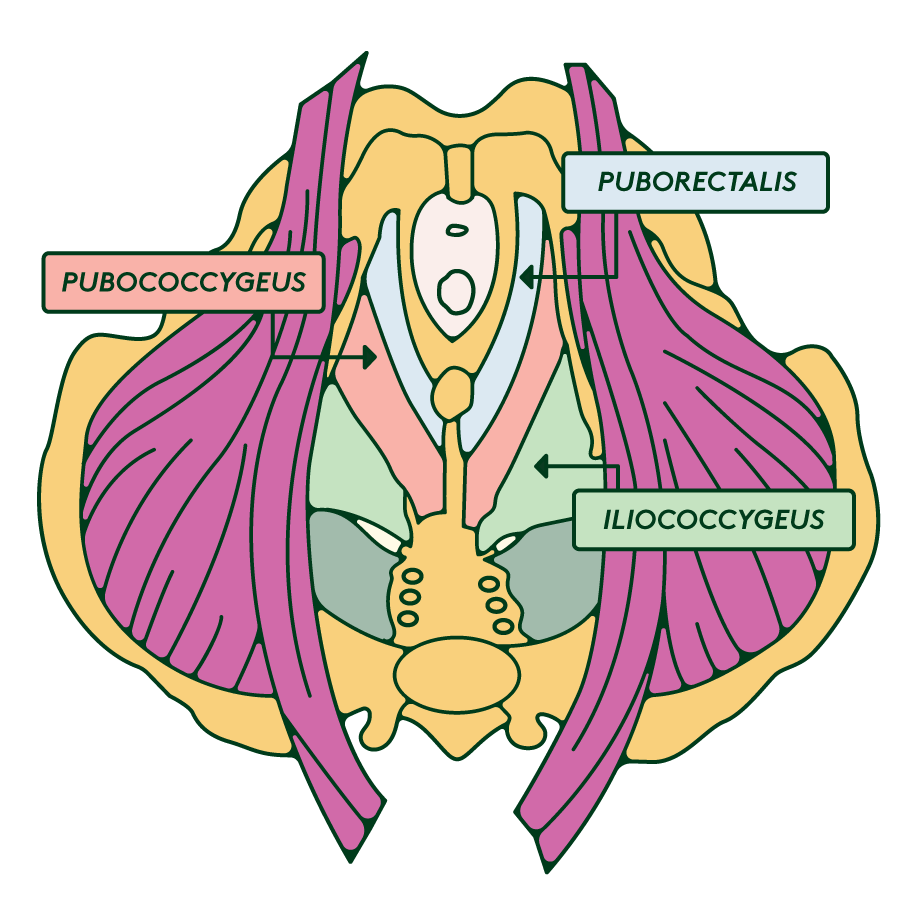The pelvic floor is a crucial part of your body, but do you know what it really is? In fact, if someone asked you to explain where it is in your body, would you know what to say? Unfortunately, most people don't really pay attention or even know where it is until it starts to affect their health. While keeping an eye on internal vaginal health is important, through methods like our at-home vaginal screening, maintaining the physical health and strength of your pelvic floor muscles is equally crucial for ensuring your reproductive health.
The pelvic floor is an intricate network of muscles, ligaments, and tissues that plays an essential role in supporting many bodily functions, which is why we've put together this comprehensive guide on everything you need to know about your pelvic floor. We'll be diving into all the details of your pelvic floor, exploring its anatomy, functions, common health conditions, and how to maintain a healthy pelvic floor.
What is the pelvic floor?
The pelvic floor is a group of muscles and connective tissue that support important internal organs located in your pelvis including your bladder, bowel, vagina, ovaries and other reproductive organs. Your pelvic floor muscles hold these organs in place and help them function.
Anatomy of the pelvis
To really understand what purpose your pelvic floor muscles serve, it's important to first understand how they fit in with the rest of your anatomy.
Pelvic floor muscles are located within your 'core' group of muscles. The pelvic floor muscles form the base of your core along with the deep abdominal muscle, back muscles, and the diaphragm. These muscles then support the spine and control the pressure inside the abdomen.
The easiest way to think about your pelvic floor muscles is to imagine a hammock made of layers of muscles, stretching from your pubic bone in the front to your tailbone in the back.
The pelvic floor muscles attach to your pubic bone at the front to the tailbone at the back and extend outward toward both sitting bones (ischeal tuborisity) on the right and left sides of your pelvis. The openings from your pelvic organs – the urethra (urine tube) from the bladder, the vagina from the uterus, and the anus from the bowel – go through the pelvic floor muscles. You can feel your pelvic floor muscles by squeezing your vaginal opening, anus, and urethra.
The main pelvic floor muscles
Remember how we described the pelvic floor muscles as being like a hammock made up of muscles and stretchy tissues that hold everything together? In AFAB folks, this hammock has two distinct parts:
The first part is like the broad part of the hammock that supports most of the weight. It's called the levator ani, which is a fancy name for a group of muscles that form a circle around the bottom of your pelvis. Think of it as a muscular sling that has three muscle components working together to keep everything in place. These three components are:
- The pubococcygeus, which is like the front line, holding up the organs in the lower belly.
- The puborectalis, which is the muscle that helps you control when you go to the bathroom.
- The iliococcygeus, which is like the backup that supports the other two muscles.
The second part is smaller and sits towards the back. It's called the coccygeus, and it's like the little knot at the end of the hammock that gives extra support, especially towards your tailbone area.
What do pelvic floor muscles do?
Pelvic floor muscles help with a variety of different bodily functions. While they serve most of the same functions in everyone's body, they also can work differently depending on whether you were assigned female at birth (AFAB) or assigned male at birth (AMAB).
Pelvic floor muscles in people who are AFAB
For those who are AFAB, your pelvic floor muscles support your bladder, bowel, urethra, vagina, uterus, anus, and rectum. These muscles contract and relax so that you're able to control when your bladder and bowel function. This is especially important if your urethral or anal sphincters aren't working optimally, which may happen after giving birth.
Pelvic floor muscles are also important for sexual function, specifically sexual sensation, as they assist with blood flow and vaginal contractions during sex and orgasm. The female pelvic floor also supports vaginal delivery during childbirth.
Pelvic floor muscles in people who are AMAB
Similarly to those who are AFAB, the pelvic floor muscles in people who are AMAB also work to support your bladder and bowel control. Again, this is especially important if your urethral and anal sphincter muscles are weak, which is common after prostate surgery.
The pelvic muscles are also essential for sexual function as they support the prostate as well as erectile function and ejaculation during sex.
Conditions & disorders linked to pelvic floor muscles
As your pelvic floor muscles support various different essential internal organs, it's really important to maintain pelvic floor health. An overly relaxed or weakened pelvic floor can lead to several different conditions that can affect your health. Likewise, excessively tight pelvic floor muscles can also cause some health issues as well.
This is why it's important to make sure you maintain that balance – your pelvis should have enough muscle strength to stabilise your core and keep your organs secure but flexible enough that they can still stretch and relax.
Weak pelvic floor muscles
There are several different causes of pelvic floor weakness, such as injury or trauma related to childbirth and surgery. These muscles can also be stressed as a result of pregnancy or overuse. You can end up overusing your pelvic floor muscles if you have a chronic cough, constipation, or are frequently lifting heavy weights. Your pelvic muscles can also weaken as you age or because of hormonal changes such as menopause.
One of the main conditions related to pelvic floor muscle weakness is urinary incontinence, which is when you can't control your bladder. Common signs of this include peeing or leaking urine whenever you laugh, cough, sneeze, or lift. You can also start experiencing urge incontinence – constantly feeling the urge to pee and being unable to control it. Other common related conditions include faecal incontinence, which is the loss of bowel control, and anal incontinence, which is uncontrollable passing wind.
Those who are AFAB are also at risk of pelvic organ prolapse, especially after menopause. This is when a weak pelvic floor is unable to support the pelvic organs such as the uterus, rectum, and bladder. Symptoms of this include a protrusion from the opening of the vagina.
Tight pelvic floor muscles
Tight pelvic floor muscles, also known as a hypertonic pelvic floor, can also cause a variety of health problems. While there isn't as much information regarding tight pelvic floor muscles, the most common causes associated with it are sexual trauma, other types of trauma or injury affecting the pelvic muscles, childbirth, and stress.
The main symptoms of a hypertonic pelvic floor include:
- Constipation
- Pelvic pain
- Painful sex
- Back, hip, and/or leg pain
- Difficulty passing urine
How can pelvic floor exercises help?
If you are experiencing weakness or tightness in your pelvic floor, don't panic! There are ways to treat it and prevent these conditions from affecting your quality of life. Pelvic floor muscles are just like all the other muscles in your body in that you can strengthen your pelvic floor muscles through regular exercise.
Identifying your pelvic floor muscles
In order to treat pelvic floor dysfunction, you need to ensure you're exercising and targeting the right muscles. To identify the correct muscles, try stopping the flow of urine midway the next time you go to the toilet. If you can do this, that means you're squeezing the right muscles. Please don’t do this often as this can be harmful to your pelvic floor muscles.
Another way to identify your pelvic floor muscles is to sit down with your legs, thighs, and buttocks relaxed. Squeeze the ring around your anus like you're trying to stop yourself from passing wind and then relax. Try squeezing and relaxing a couple of times until you're sure that you're using the correct muscles.
If you're still having trouble using the right muscles, we recommend going to a pelvic floor physiotherapist as they'll be able to ensure that you're using your pelvic floor muscles and can prescribe the best exercises for your body.
Pelvic floor exercises for muscle strengthening
Pelvic floor muscle exercises, also known as kegel exercises, are the best way to address pelvic floor weakness. These exercises will involve squeezing and relaxing your pelvic floor muscles, which will then help you build control. There are a few different types of pelvic floor muscle exercises out there, and we'll be guiding you through one of the most popular and effective ones.
To start, you'll need to sit or lie on your back with your knees bent and legs comfortably apart. Once you've identified your pelvic floor muscles, start tightening them as much as possible around your front passage, vagina, and back passage. Hold this position for a maximum of eight seconds before you let go. Take a break for a few seconds before repeating this several times until you feel your pelvic muscles are tired.
It's really important that you do these pelvic floor exercises correctly in order to strengthen your pelvis. If you ever have any doubts, you should definitely consult your GP or
physiotherapist for advice.
Treating a tight pelvic floor
A hypertonic pelvic floor typically means your muscles aren't as flexible as they should be, so pelvic floor exercises may not be as effective. Instead, treatments will include physical therapy, breathing and relaxation techniques, medication, injections into your pelvic floor, and possibly cognitive behavioural therapy.
Final thoughts
Your pelvic floor is one of the most important parts of your body, controlling vital organ functions and maintaining your overall well-being. By having a better understanding of its anatomy, functions, potential issues and treatment options, you'll be able to maintain a healthy pelvic floor which can then help you live a healthier life while building social confidence.
While we hope this guide has helped you understand your pelvic floor and body more, you'll still need to consult with a doctor or physiotherapist if you do sense something wrong. Don't hesitate to reach out if you're experiencing any of the symptoms we've mentioned and remember: there's nothing to ever be ashamed about when it comes to your body and health.


.png?ixlib=gatsbyFP&auto=compress%2Cformat&fit=max&w=1080&h=1080)




